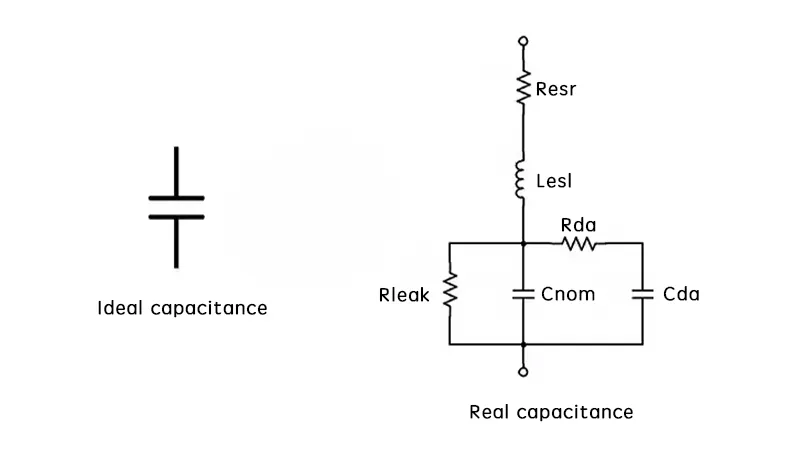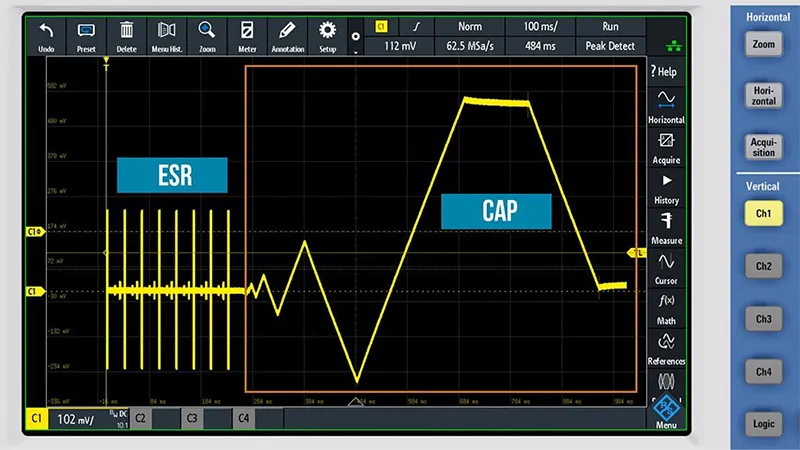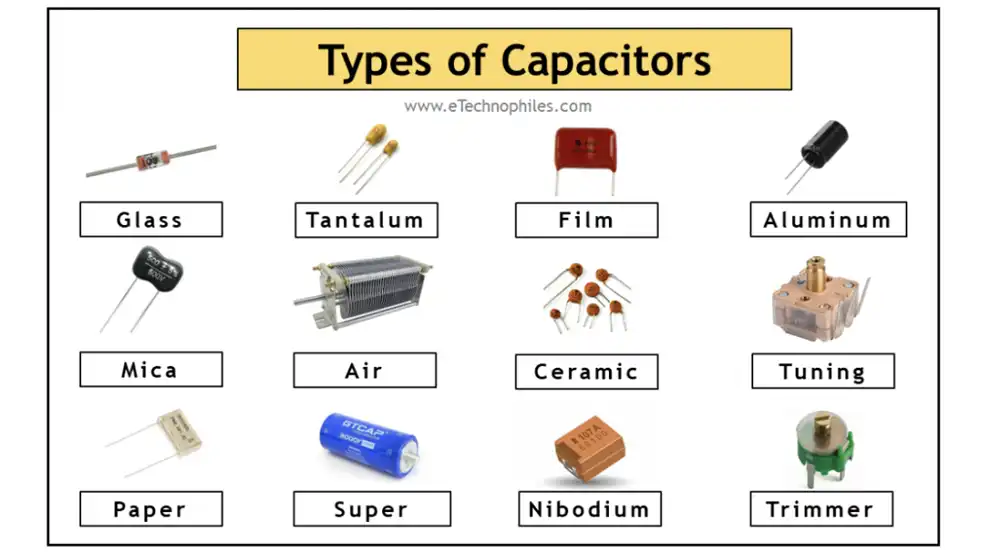Capacitors are fundamental components in electronic circuits, storing and releasing energy as needed. One key parameter that affects a capacitor’s performance is Equivalent Series Resistance (ESR). Understanding ESR is crucial for designing efficient and reliable circuits.
In this article, we’ll explore what ESR in capacitors is, how it affects performance, and why it matters.
What is ESR in Capacitors?

Equivalent Series Resistance (ESR) in capacitors refers to the internal resistance that appears in series with the capacitance. Essentially, it’s like a tiny resistor that’s part of the capacitor itself. This resistance arises due to various factors such as the materials used in the capacitor’s construction, the structure of its electrodes, and the dielectric material between them.
When an alternating current (AC) flows through a capacitor, it encounters this internal resistance. Unlike an ideal capacitor, which would have no resistance, real-world capacitors exhibit some level of ESR. This resistance affects the capacitor’s performance, particularly in terms of energy dissipation and heat generation.
Understanding and managing ESR is crucial for optimizing the efficiency and reliability of electronic circuits, particularly in high-frequency applications.
How to Measure ESR of a Capacitor?

Measuring the Equivalent Series Resistance (ESR) of a capacitor is a straightforward process that requires the use of an ESR meter. Here’s a detailed guide on how to accurately measure the ESR of a capacitor:
Disconnect the Capacitor: Before measuring, ensure that the capacitor is fully discharged and disconnected from any circuitry. This prevents any interference from other components.
Prepare the ESR Meter: Set up your ESR meter according to the manufacturer’s instructions. Make sure the meter is properly calibrated for accurate readings.
Connect the Capacitor: Attach the ESR meter’s leads to the capacitor’s terminals. Ensure a secure connection to obtain reliable measurements.
Start the Measurement: Activate the ESR meter to begin the measurement process. The meter will send a small test signal through the capacitor and analyze the response to determine the ESR value.
Read the Result: Once the measurement is complete, the ESR meter will display the ESR value in ohms. Take note of this value for further analysis.
Interpret the Result: Compare the measured ESR value with the specifications provided by the capacitor manufacturer or industry standards. A higher ESR value may indicate a degraded or faulty capacitor, while a lower value suggests better performance.
Repeat if Necessary: For accurate results, consider measuring the ESR of the capacitor multiple times and averaging the values. This helps to account for any variability in the measurements.
Why is The ESR in Capacitors Important?
Impact on Efficiency: ESR affects how efficiently a capacitor can store and release energy. Higher ESR results in increased power loss and reduced efficiency, particularly in high-frequency applications where rapid energy transfer is essential.
Heat Generation: The presence of ESR causes energy dissipation within the capacitor, leading to heat generation. Excessive heat can degrade the capacitor’s performance over time and even cause it to fail prematurely. Therefore, minimizing ESR helps reduce heat buildup and ensure electronic components’ longevity.
Voltage Regulation: In power supply circuits, capacitors are used to stabilize voltage levels by filtering out fluctuations. Capacitors with low ESR are more effective in this role as they can respond quickly to changes in voltage, maintaining a stable output.
Signal Integrity: In high-frequency circuits such as radio frequency (RF) applications, maintaining signal integrity is critical. Capacitors with low ESR ensure minimal signal loss and distortion, preserving the quality of the transmitted or received signals.
Reliability: Capacitors with high ESR are more prone to failure, especially under demanding operating conditions. By selecting capacitors with low ESR values, engineers can improve the overall reliability of their electronic systems, reducing the risk of costly downtime and repairs.
Efficient Power Delivery: In circuits with high current requirements, such as motor drives or power inverters, low ESR capacitors facilitate efficient power delivery by minimizing voltage drops and energy losses across the capacitor.
ESR and Capacitor Types

Different types of capacitors exhibit varying levels of Equivalent Series Resistance (ESR), and this characteristic significantly influences their performance in electronic circuits. Understanding the ESR properties of each capacitor type helps in selecting the right capacitor for specific applications.
Electrolytic Capacitors: These capacitors are known for their high capacitance values, making them suitable for applications requiring significant energy storage. However, they generally have higher ESR compared to other types, which can lead to greater power losses and heat generation. This makes them less ideal for high-frequency applications where low ESR is crucial. Despite this, electrolytic capacitors are commonly used in power supply filters and audio circuits due to their large capacitance.
Ceramic Capacitors: Ceramic capacitors are prized for their low ESR, making them highly effective in high-frequency and high-speed circuits. Their small size and stability over a wide temperature range further enhance their suitability for applications like RF circuits, decoupling, and bypass capacitors in digital electronics. However, their capacitance values are typically lower than those of electrolytic capacitors.
Tantalum Capacitors: These capacitors offer a middle ground with lower ESR than electrolytic capacitors but higher than ceramic capacitors. Tantalum capacitors are known for their reliability and stability, making them suitable for precision applications and situations where space is limited. They are commonly used in military and aerospace electronics due to their robustness.
Film Capacitors: Film capacitors have very low ESR and excellent stability over time and temperature changes. They are ideal for applications requiring high reliability and performance, such as audio equipment, industrial electronics, and power conditioning. Their only drawback is that they can be larger and more expensive compared to other types for the same capacitance value.
Polymer Capacitors: These are advanced types of electrolytic capacitors with significantly lower ESR. They are used in applications that demand high performance and long lifespans, such as motherboards, servers, and other high-end electronics.
Here’s a comparative table highlighting the pros and cons of these capacitor types:
| Capacitor Type | ESR Level | Advantages | Disadvantages |
|---|---|---|---|
| Electrolytic | High | High capacitance, low cost | High ESR, high leakage, limited lifespan |
| Ceramic | Low | Low ESR, high frequency performance, small size | Low capacitance, can crack under mechanical stress |
| Tantalum | Medium | Stable, reliable, good performance for size | Moderate ESR, more expensive than electrolytics |
| Film | Very Low | Low ESR, excellent stability and reliability | Larger size, higher cost |
| Polymer | Very Low | Low ESR, long lifespan, high performance | Higher cost than traditional electrolytics |
FAQ
Are low ESR capacitors better?
Low ESR capacitors offer significant advantages in terms of efficiency, heat management, and performance, particularly in high-frequency and high-current applications. They are essential in modern electronics where reliability and performance are paramount.
However, for low-frequency applications or cost-sensitive designs, the benefits of low ESR may not justify the additional expense. Therefore, while low ESR capacitors are often better, the choice depends on the specific requirements of the application.
Do parallel capacitors reduce ESR?
Yes, parallel capacitors can help reduce the Equivalent Series Resistance (ESR) effectively in electronic circuits. When capacitors are connected in parallel, their individual ESR values combine in a manner that reduces the overall ESR of the combination.
Which capacitors have the lowest ESR?
The term “low ESR” for capacitors doesn’t have a standardized rating. Polymer capacitors typically exhibit lower ESR compared to wet-electrolytic capacitors of the same capacitance value.
Additionally, polymer capacitors maintain stability across varying temperatures, making them reliable components in diverse environments. Due to their inherently lower ESR, polymer capacitors can effectively handle higher levels of ripple current without compromising performance or longevity.
Does ESR change with frequency?
Yes, Equivalent Series Resistance (ESR) typically changes with frequency in capacitors.
Frequency Dependency: ESR is not a static value; it can vary depending on the frequency of the alternating current passing through the capacitor. At lower frequencies, the ESR may appear relatively constant. However, as the frequency increases, the ESR of the capacitor tends to rise.
Effects of High Frequency: At higher frequencies, the behavior of the dielectric material and internal components within the capacitor changes. This can lead to an increase in ESR due to factors such as dielectric losses, internal inductance, and parasitic effects.
Conclusion
Understanding ESR in capacitors is crucial for designing efficient electronic circuits. By selecting capacitors with appropriate ESR values, you can enhance performance, reduce power loss, and ensure the longevity of your electronic devices. Whether you’re working on power supplies, audio circuits, or RF applications, keeping ESR in mind will help you achieve optimal results.




















